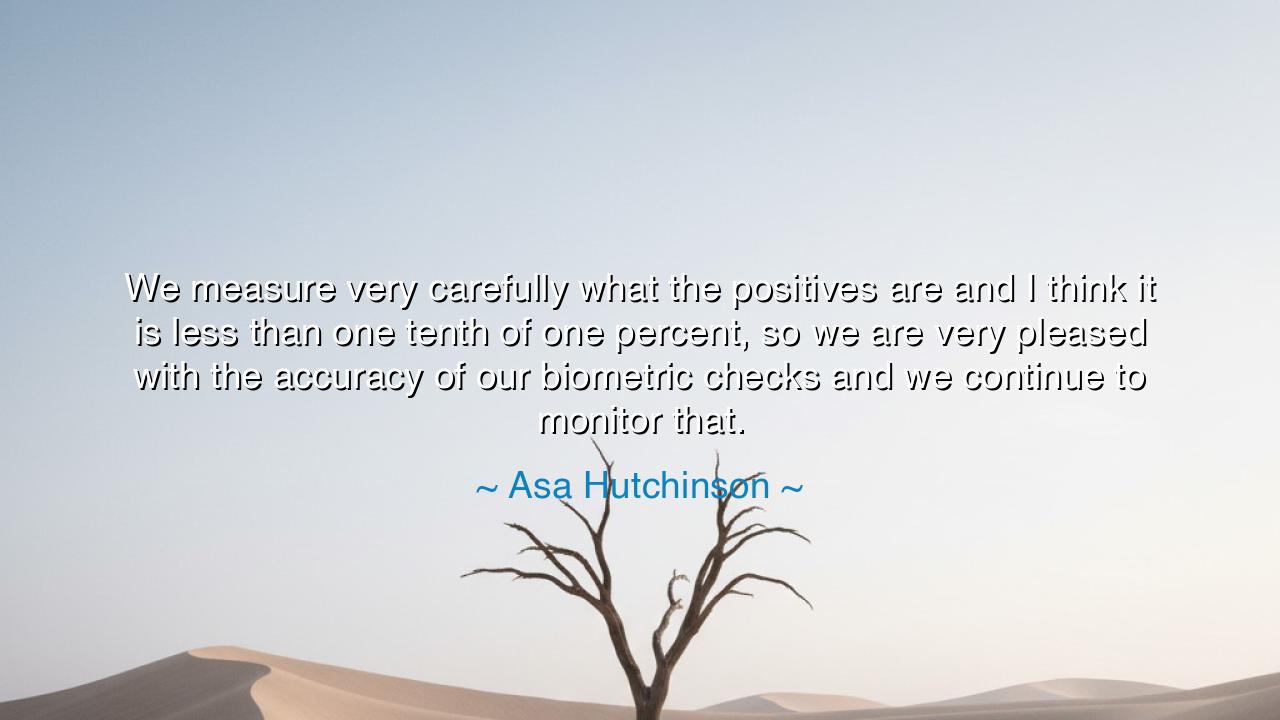
We measure very carefully what the positives are and I think it
We measure very carefully what the positives are and I think it is less than one tenth of one percent, so we are very pleased with the accuracy of our biometric checks and we continue to monitor that.






The words of Asa Hutchinson—“We measure very carefully what the positives are and I think it is less than one tenth of one percent, so we are very pleased with the accuracy of our biometric checks and we continue to monitor that.”—may sound technical on the surface, yet within them lies a profound lesson about vigilance, responsibility, and the pursuit of precision. He speaks of measurement, of accuracy, of the discipline of not assuming but knowing. And though he addresses the realm of biometric systems, his words echo an eternal principle: that human progress depends not only on ambition, but on the care with which we test, refine, and safeguard our actions.
The ancients knew well the importance of careful measurement. The Egyptians, when raising their colossal pyramids, could not rely on approximation; a single error in alignment could doom the work of thousands. The Greeks, too, learned to measure the heavens with painstaking care, knowing that even a fraction of error would misguide sailors or scholars. Hutchinson’s words belong to this same tradition of reverence for accuracy: when dealing with systems that affect human lives and trust, one must not speak loosely, but must measure with diligence, knowing that each number carries weight.
History offers a striking example in the work of Florence Nightingale during the Crimean War. She carefully measured mortality rates, infection patterns, and the effects of sanitation, at a time when medicine was often ruled by superstition and guesswork. Through precise observation and unrelenting accuracy, she proved that cleanliness and ventilation reduced deaths, saving countless lives. Her devotion to detail echoes Hutchinson’s point: when accuracy is pursued and error minimized, lives are protected, trust is built, and progress becomes real.
There is also in Hutchinson’s words a call to humility. For even when boasting of a rate as low as one tenth of one percent, he acknowledges the need to continue to monitor. This humility is wisdom. The ancients would say that pride in perfection is folly, for the world is ever-changing, and human systems are never flawless. To monitor continually is to accept that vigilance is eternal—that accuracy is not a destination but a journey, one that demands constancy and care.
On a deeper level, his reflection reminds us that truth in life often lies in small margins. Great victories or great failures may turn not on vast differences, but on the tiniest errors or the smallest disciplines. A bridge collapses for want of a single bolt; an empire falls through a misjudged choice; a life is saved through the smallest timely intervention. To honor the small percentage, to guard even against the fraction of a mistake, is to recognize that greatness is often safeguarded in details unseen.
The lesson for us is profound: whether in governance, in craft, in relationships, or in the cultivation of our own character, we must be careful measurers. Do not assume you are right—test, monitor, and refine. Celebrate accuracy, but never stop guarding it. Understand that even a fraction of error, left unchecked, can grow into calamity. And, like Hutchinson’s counsel, let vigilance be paired with satisfaction: rejoice in what you have achieved, but never abandon the watchfulness that preserves it.
So, dear listener, carry this wisdom into your own life. Be deliberate in your words, precise in your actions, and humble in your victories. Remember that measurement, accuracy, and monitoring are not the dry tasks of bureaucracy alone, but sacred disciplines that protect truth, preserve trust, and shape the destiny of individuals and nations alike. For those who measure carefully walk with clarity, and those who monitor with humility walk with endurance. And in this balance of diligence and vigilance lies the path of lasting greatness.






CChau
This quote highlights confidence in technology, yet it raises broader societal questions. Even a tiny fraction of errors can have significant consequences depending on context—such as law enforcement or border control. I wonder how the agency addresses potential biases in biometric systems, for example, across different ethnicities or age groups. Is there a public mechanism to review mistakes, and how is trust maintained in a system where even a fraction of a percent could affect real people’s lives?
ANNguyen Hoang An nhien
Reading this, I’m intrigued by the focus on precision in biometric verification, but I question how it intersects with privacy concerns. How is personal data being stored and protected from misuse? Furthermore, does the claim of high accuracy consider real-world scenarios, such as changes in appearance or environmental conditions that could affect readings? I’d like to understand how accuracy is measured over time and what accountability measures exist if errors occur, particularly in sensitive contexts like security or law enforcement.
THTrinh Trung Hao
I find this statistic interesting, but it prompts concerns about context and interpretation. Does the extremely low positive rate reflect system accuracy or limited sample diversity? How frequently is the monitoring updated to account for potential technological errors or spoofing attempts? I also wonder whether there is transparency in reporting false negatives, as those could have serious implications. How do these figures compare with other similar biometric systems worldwide?
DPTrinh Duc Phat
This statement raises questions about the reliability and transparency of biometric systems. While the reported accuracy seems impressive, I wonder how the one-tenth of one percent error rate affects individuals in practice. Are there safeguards for people who might be misidentified? Additionally, what types of biometric checks are being used, and how is the data protected? I’m also curious whether external audits or independent verification are conducted to ensure these claims are accurate and unbiased.